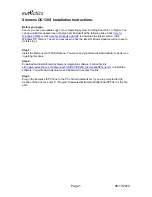
Soundscape Mixpander
Page 9 of 109
output to a sequencer track, and then mute the real-time effect to save processing power for other
purposes.
NOTE:
Pressing
the
BP
button
(bypass)
for
an
element
does
not
reduce
the
DSP
power
consumption,
as
the
element
is
still
instantly
available.
Only
muting
the
element
with
the
Mute
tool
will
reduce
the
DSP
power
used.
Each mixer element consumes a certain percentage of DSP resources and the total percentage of
DSP processing (P) and memory (M) resources used (i.e., the average percentage of resources used
per DSP) is shown in the Status Bar at the bottom of the SSL Soundscape Mixer window (the Status
Bar can be shown or hidden by ticking or unticking the “Status Bar” item under the View menu).
The total (P) and (M) resources available vary for different DSPs. DSPs 1 and 5 have identical
resources. DSPs 2, 3, 4, 6, 7 and 8 resources are also identical, but different from DSP1 and DSP5
resources.
For instance, on DSP 1 or DSP 5, a single mono mixer column with output fader is around (P)0.5%
(M)1.3%, the 2 band mono EQ is (P)1.4% (M)1.1% and the stereo TC Reverb is (P)29.7% (M)11.9%.
On DSPs 2, 3, 4, 6, 7 and 8, the figures are the same for the single mono mixer column with output
fader and the 2 band mono EQ, but they are different at (P)26.8% (M)52.0% for the stereo TC
Reverb.
The DSP power percentage that is reported as being used for each element is the
maximum
percentage that this element will use. In reality, there are several parameters that are important to
the DSP, for example processing time, and program and memory requirements. This means that
when two elements are combined, the overall DSP power requirement may be less than the sum of
both percentages (i.e., one element may need more memory and the other may take more
processing time, but with less memory used). In this case one algorithm is “masking” the power
requirement for the other.
With multiple SSL Mixpander cards installed, the percentages are shown individually for each
card. For cards with multiple DSPs (Mixpander/5 or Mixpander/9, the percentages relate to the
total resources of all DSPs.
The (C) percentage shows the connection resources usage.










































